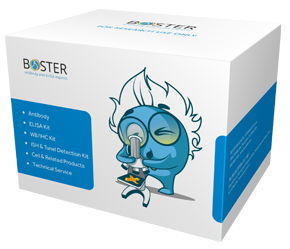Product Info Summary
| SKU: | A01291-1 |
|---|---|
| Size: | 100 μg/vial |
| Reactive Species: | Human, Mouse, Rat |
| Host: | Rabbit |
| Application: | ELISA, Flow Cytometry, IHC, ICC, WB |
Customers Who Bought This Also Bought
Product info
Product Name
Anti-Cannabinoid Receptor I/CNR1 Antibody Picoband®
View all Cannabinoid R1/CB1/CNR1 Antibodies
SKU/Catalog Number
A01291-1
Size
100 μg/vial
Form
Lyophilized
Description
Boster Bio Anti-Cannabinoid Receptor I/CNR1 Antibody Picoband® catalog # A01291-1. Tested in ELISA, Flow Cytometry, IHC, ICC, WB applications. This antibody reacts with Human, Mouse, Rat. The brand Picoband indicates this is a premium antibody that guarantees superior quality, high affinity, and strong signals with minimal background in Western blot applications. Only our best-performing antibodies are designated as Picoband, ensuring unmatched performance.
Storage & Handling
Store at -20˚C for one year from date of receipt. After reconstitution, at 4˚C for one month. It can also be aliquotted and stored frozen at -20˚C for six months. Avoid repeated freeze-thaw cycles.
Cite This Product
Anti-Cannabinoid Receptor I/CNR1 Antibody Picoband® (Boster Biological Technology, Pleasanton CA, USA, Catalog # A01291-1)
Host
Rabbit
Contents
Each vial contains 4mg Trehalose, 0.9mg NaCl, 0.2mg Na2HPO4, 0.05mg NaN3.
Clonality
Polyclonal
Isotype
Rabbit IgG
Immunogen
E. coli-derived human Cannabinoid Receptor I recombinant protein (Position: M1-Q75).
*Blocking peptide can be purchased. Costs vary based on immunogen length. Contact us for pricing.
Cross-reactivity
No cross-reactivity with other proteins.
Reactive Species
A01291-1 is reactive to CNR1 in Human, Mouse, Rat
Reconstitution
Add 0.2ml of distilled water will yield a concentration of 500ug/ml.
Observed Molecular Weight
60 kDa
Calculated molecular weight
52.858kDa
Background of Cannabinoid R1/CB1/CNR1
The cannabinoid receptor type 1, often abbreviated as CB1, is a G protein-coupled cannabinoid receptor located primarily in the central and peripheral nervous system. This gene encodes one of two cannabinoid receptors. The cannabinoids, principally delta-9-tetrahydrocannabinol and synthetic analogs, are psychoactive ingredients of marijuana. The cannabinoid receptors are members of the guanine-nucleotide-binding protein (G-protein) coupled receptor family, which inhibit adenylate cyclase activity in a dose-dependent, stereoselective and pertussis toxin-sensitive manner. The two receptors have been found to be involved in the cannabinoid-induced CNS effects (including alterations in mood and cognition) experienced by users of marijuana. Multiple transcript variants encoding two different protein isoforms have been described for this gene.
Antibody Validation
Boster validates all antibodies on WB, IHC, ICC, Immunofluorescence, and ELISA with known positive control and negative samples to ensure specificity and high affinity, including thorough antibody incubations.
Application & Images
Applications
A01291-1 is guaranteed for ELISA, Flow Cytometry, IHC, ICC, WB Boster Guarantee
Assay Dilutions Recommendation
The recommendations below provide a starting point for assay optimization. The actual working concentration varies and should be decided by the user.
Western blot, 0.1-0.5μg/ml
Immunohistochemistry (Paraffin-embedded Section), 0.5-1μg/ml
Immunohistochemistry (Frozen Section), 0.5-1μg/ml
Immunocytochemistry, 0.5-1μg/ml
Flow Cytometry (Fixed), 1-3μg/1x106 cells
ELISA, 0.1-0.5μg/ml
Positive Control
WB: human 22RV1 whole cell
IHC: mouse small intestine tissue, rat small intestine tissue
FCM: Hela cell
Validation Images & Assay Conditions
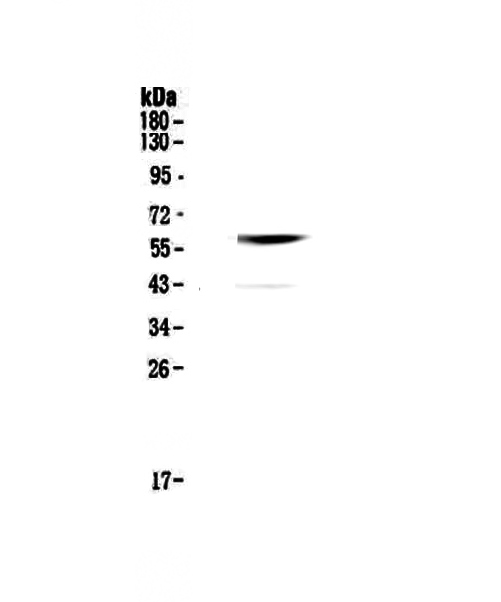
Click image to see more details
Figure 1. Western blot analysis of Cannabinoid Receptor I using anti-Cannabinoid Receptor I antibody (A01291-1).
Electrophoresis was performed on a 5-20% SDS-PAGE gel at 70V (Stacking gel) / 90V (Resolving gel) for 2-3 hours. The sample well of each lane was loaded with 50ug of sample under reducing conditions.
Lane 1: human 22RV1 whole cell lysates.
After Electrophoresis, proteins were transferred to a Nitrocellulose membrane at 150mA for 50-90 minutes. Blocked the membrane with 5% Non-fat Milk/ TBS for 1.5 hour at RT. The membrane was incubated with rabbit anti-Cannabinoid Receptor I antigen affinity purified polyclonal antibody (Catalog # A01291-1) at 0.5 μg/mL overnight at 4°C, then washed with TBS-0.1%Tween 3 times with 5 minutes each and probed with a goat anti-rabbit IgG-HRP secondary antibody at a dilution of 1:10000 for 1.5 hour at RT. The signal is developed using an Enhanced Chemiluminescent detection (ECL) kit (Catalog # EK1002) with Tanon 5200 system. A specific band was detected for Cannabinoid Receptor I at approximately 60KD. The expected band size for Cannabinoid Receptor I is at 53KD.
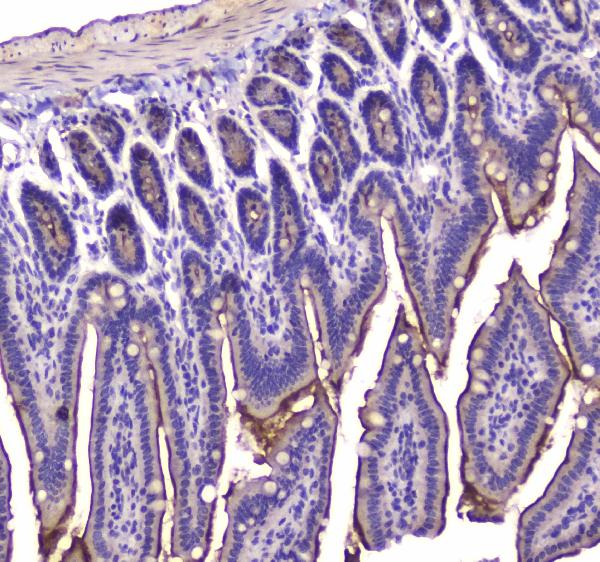
Click image to see more details
Figure 2. IHC analysis of Cannabinoid Receptor I using anti-Cannabinoid Receptor I antibody (A01291-1).
Cannabinoid Receptor I was detected in paraffin-embedded section of mouse small intestine tissue. Heat mediated antigen retrieval was performed in citrate buffer (pH6, epitope retrieval solution) for 20 mins. The tissue section was blocked with 10% goat serum. The tissue section was then incubated with 1μg/ml rabbit anti-Cannabinoid Receptor I Antibody (A01291-1) overnight at 4°C. Biotinylated goat anti-rabbit IgG was used as secondary antibody and incubated for 30 minutes at 37°C. The tissue section was developed using Strepavidin-Biotin-Complex (SABC)(Catalog # SA1022) with DAB as the chromogen.
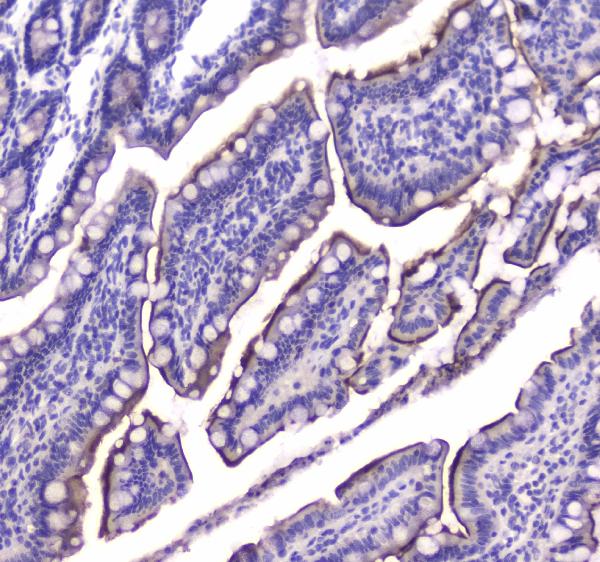
Click image to see more details
Figure 3. IHC analysis of Cannabinoid Receptor I using anti-Cannabinoid Receptor I antibody (A01291-1).
Cannabinoid Receptor I was detected in paraffin-embedded section of rat small intestine tissue. Heat mediated antigen retrieval was performed in citrate buffer (pH6, epitope retrieval solution) for 20 mins. The tissue section was blocked with 10% goat serum. The tissue section was then incubated with 1μg/ml rabbit anti-Cannabinoid Receptor I Antibody (A01291-1) overnight at 4°C. Biotinylated goat anti-rabbit IgG was used as secondary antibody and incubated for 30 minutes at 37°C. The tissue section was developed using Strepavidin-Biotin-Complex (SABC)(Catalog # SA1022) with DAB as the chromogen.
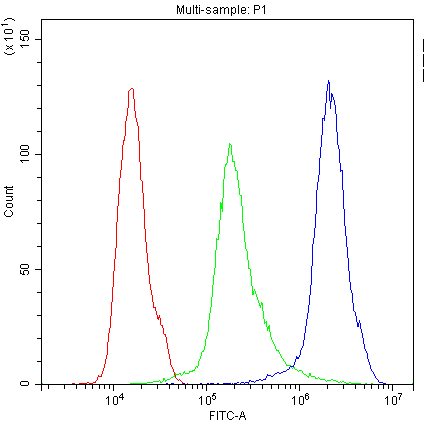
Click image to see more details
Figure 4. Flow Cytometry analysis of Hela cells using anti-CNR1 antibody (A01291-1).
Overlay histogram showing Hela cells stained with A01291-1 (Blue line). The cells were fixed with 4% paraformaldehyde and blocked with 10% normal goat serum. And then incubated with rabbit anti-CNR1 Antibody (A01291-1,1μg/1x106 cells) for 30 min at 20°C. DyLight®488 conjugated goat anti-rabbit IgG (BA1127, 5-10μg/1x106 cells) was used as secondary antibody for 30 minutes at 20°C. Isotype control antibody (Green line) was rabbit IgG (1μg/1x106) used under the same conditions. Unlabelled sample without incubation with primary antibody and secondary antibody (Red line) was used as a blank control.
Protein Target Info & Infographic
Gene/Protein Information For CNR1 (Source: Uniprot.org, NCBI)
Gene Name
CNR1
Full Name
Cannabinoid receptor 1
Weight
52.858kDa
Superfamily
G-protein coupled receptor 1 family
Alternative Names
Cannabinoid receptor 1; CB-R; CB1; CANN6; CNR1; CNR CNR1 CANN6, CB-R, CB1, CB1A, CB1K5, CB1R, CNR cannabinoid receptor 1 cannabinoid receptor 1|cannabinoid receptor 1 (brain)|central cannabinoid receptor
*If product is indicated to react with multiple species, protein info is based on the gene entry specified above in "Species".For more info on CNR1, check out the CNR1 Infographic

We have 30,000+ of these available, one for each gene! Check them out.
In this infographic, you will see the following information for CNR1: database IDs, superfamily, protein function, synonyms, molecular weight, chromosomal locations, tissues of expression, subcellular locations, post-translational modifications, and related diseases, research areas & pathways. If you want to see more information included, or would like to contribute to it and be acknowledged, please contact [email protected].
Specific Publications For Anti-Cannabinoid Receptor I/CNR1 Antibody Picoband® (A01291-1)
Hello CJ!
A01291-1 has been cited in 1 publications:
*The publications in this section are manually curated by our staff scientists. They may differ from Bioz's machine gathered results. Both are accurate. If you find a publication citing this product but is missing from this list, please let us know we will issue you a thank-you coupon.
The Roles of Anandamide, Fatty Acid Amide Hydrolase, and Leukemia Inhibitory Factor on the Endometrium during the Implantation Window
Recommended Resources
Here are featured tools and databases that you might find useful.
- Boster's Pathways Library
- Protein Databases
- Bioscience Research Protocol Resources
- Data Processing & Analysis Software
- Photo Editing Software
- Scientific Literature Resources
- Research Paper Management Tools
- Molecular Biology Software
- Primer Design Tools
- Bioinformatics Tools
- Phylogenetic Tree Analysis
Customer Reviews
Have you used Anti-Cannabinoid Receptor I/CNR1 Antibody Picoband®?
Submit a review and receive an Amazon gift card.
- $30 for a review with an image
0 Reviews For Anti-Cannabinoid Receptor I/CNR1 Antibody Picoband®
Customer Q&As
Have a question?
Find answers in Q&As, reviews.
Can't find your answer?
Submit your question
7 Customer Q&As for Anti-Cannabinoid Receptor I/CNR1 Antibody Picoband®
Question
How was A01291-1 purified from rabbit serum?
Verified customer
Asked: 2022-06-07
Answer
The Anti-Cannabinoid Receptor I/CNR1 Antibody Picoband™ (A01291-1) is immunogen affinity purified.
Boster Scientific Support
Answered: 2022-06-08
Question
We bought anti-Cannabinoid Receptor I/CNR1 antibody for ICC on brain in a previous experiment. I am using human, and We are going to use the antibody for Flow Cytometry next. I was wanting to use examining brain as well as lung in our next experiment. Could you please give me some suggestion on which antibody would work the best for Flow Cytometry?
Verified Customer
Verified customer
Asked: 2020-05-05
Answer
I looked at the website and datasheets of our anti-Cannabinoid Receptor I/CNR1 antibody and it appears that A01291-1 has been validated on human in both ICC and Flow Cytometry. Thus A01291-1 should work for your application. Our Boster satisfaction guarantee will cover this product for Flow Cytometry in human even if the specific tissue type has not been validated. We do have a comprehensive range of products for Flow Cytometry detection and you can check out our website bosterbio.com to find out more information about them.
Boster Scientific Support
Answered: 2020-05-05
Question
My team were content with the WB result of your anti-Cannabinoid Receptor I/CNR1 antibody. However we have been able to see positive staining in brain stem cell membrane using this antibody. Is that expected? Could you tell me where is CNR1 supposed to be expressed?
G. Dhar
Verified customer
Asked: 2020-01-28
Answer
From what I have seen in literature, brain stem does express CNR1. Generally CNR1 expresses in cell membrane. Regarding which tissues have CNR1 expression, here are a few articles citing expression in various tissues:
Brain, Pubmed ID: 17895407
Brain stem, Pubmed ID: 1718258, 2263478
Fetal brain, Pubmed ID: 15620723
Hippocampus, Pubmed ID: 14702039
Lung, Pubmed ID: 7876112, 15489334
Boster Scientific Support
Answered: 2020-01-28
Question
I am looking for using your anti-Cannabinoid Receptor I/CNR1 antibody for g protein-coupled receptor signaling pathway studies. Has this antibody been tested with western blotting on small intestine tissue? We would like to see some validation images before ordering.
Verified Customer
Verified customer
Asked: 2019-09-24
Answer
We appreciate your inquiry. This A01291-1 anti-Cannabinoid Receptor I/CNR1 antibody is tested on human 22rv1 whole cell lysates, small intestine tissue, hela cells. It is guaranteed to work for ELISA, Flow Cytometry, IHC, ICC, WB in human, mouse, rat. Our Boster guarantee will cover your intended experiment even if the sample type has not been be directly tested.
Boster Scientific Support
Answered: 2019-09-24
Question
We are currently using anti-Cannabinoid Receptor I/CNR1 antibody A01291-1 for rat tissue, and we are happy with the ICC results. The species of reactivity given in the datasheet says human, mouse, rat. Is it likely that the antibody can work on pig tissues as well?
Verified Customer
Verified customer
Asked: 2019-01-31
Answer
The anti-Cannabinoid Receptor I/CNR1 antibody (A01291-1) has not been validated for cross reactivity specifically with pig tissues, but there is a good chance of cross reactivity. We have an innovator award program that if you test this antibody and show it works in pig you can get your next antibody for free. Please contact me if I can help you with anything.
Boster Scientific Support
Answered: 2019-01-31
Question
What is the meaning of picoband antibody especially for cannabinoids receptor 1 antibody and how is it different from the ordinary antibody?
Verified customer
Asked: 2018-12-30
Answer
Boster's Picoband antibodies are our proprietary antibodies that are hand-picked for high affinity, so they have higher affinity compared to non-picoband antibodies. Boster also tests antibodies quantitatively on Western Blot, and only those that react with as little as 1 ng of antigen will qualify as Picoband. (In reference to Anti-Cannabinoid Receptor I/CNR1 Picoband Antibody A01291-1) As for the non-picoband Anti-Cannabinoid Receptor 1 Antibody A01291, you can compare the two product pages for the technical differences. The main difference is that this is a sourced product.
Boster Scientific Support
Answered: 2018-12-30
Question
We have observed staining in rat fetal brain. Any tips? Is anti-Cannabinoid Receptor I/CNR1 antibody supposed to stain fetal brain positively?
Verified Customer
Verified customer
Asked: 2017-10-25
Answer
From literature fetal brain does express CNR1. From Uniprot.org, CNR1 is expressed in caudate nucleus, brain stem, lung, fetal brain, hippocampus, brain tumor, brain, among other tissues. Regarding which tissues have CNR1 expression, here are a few articles citing expression in various tissues:
Brain, Pubmed ID: 17895407
Brain stem, Pubmed ID: 1718258, 2263478
Fetal brain, Pubmed ID: 15620723
Hippocampus, Pubmed ID: 14702039
Lung, Pubmed ID: 7876112, 15489334
Boster Scientific Support
Answered: 2017-10-25



